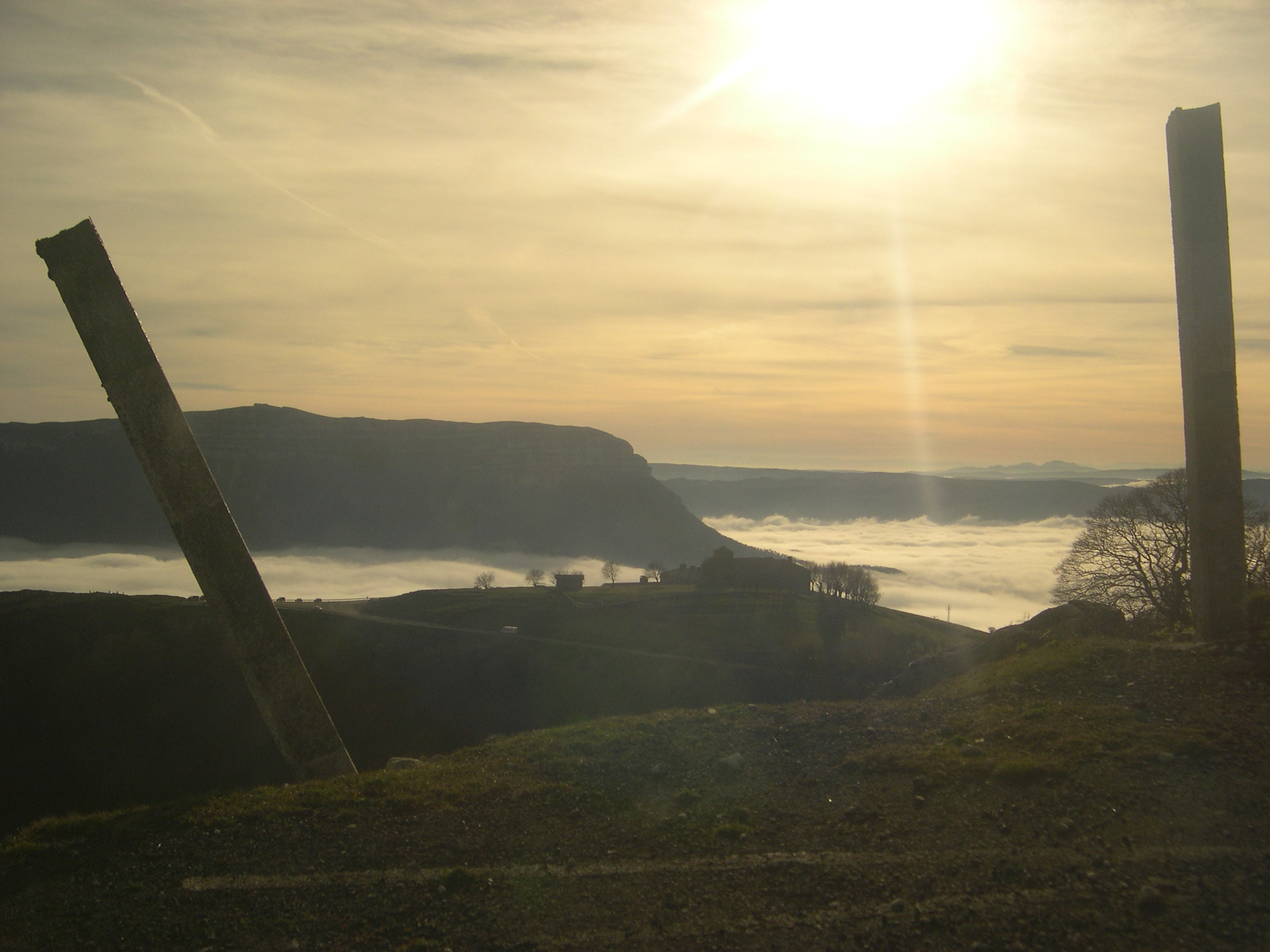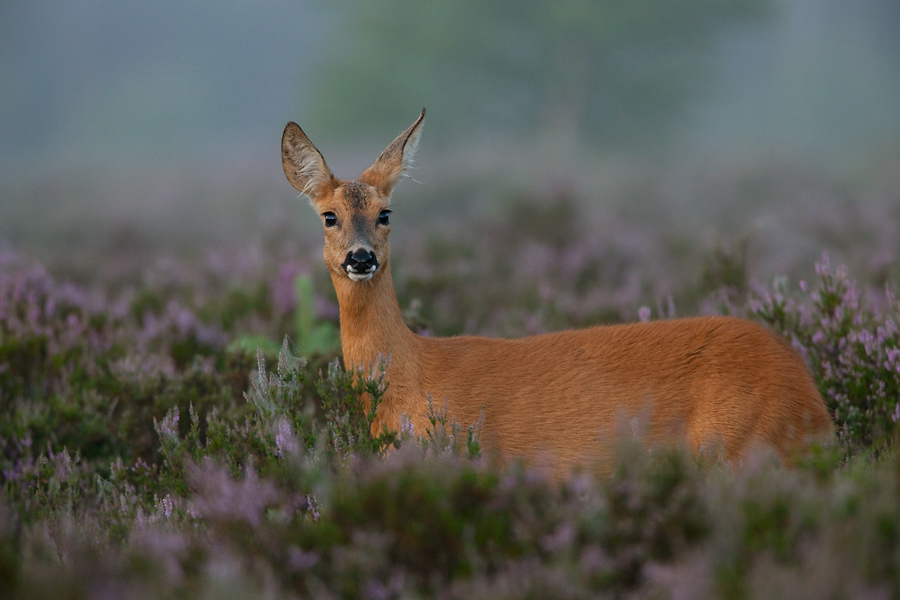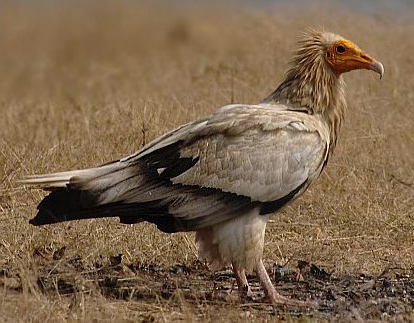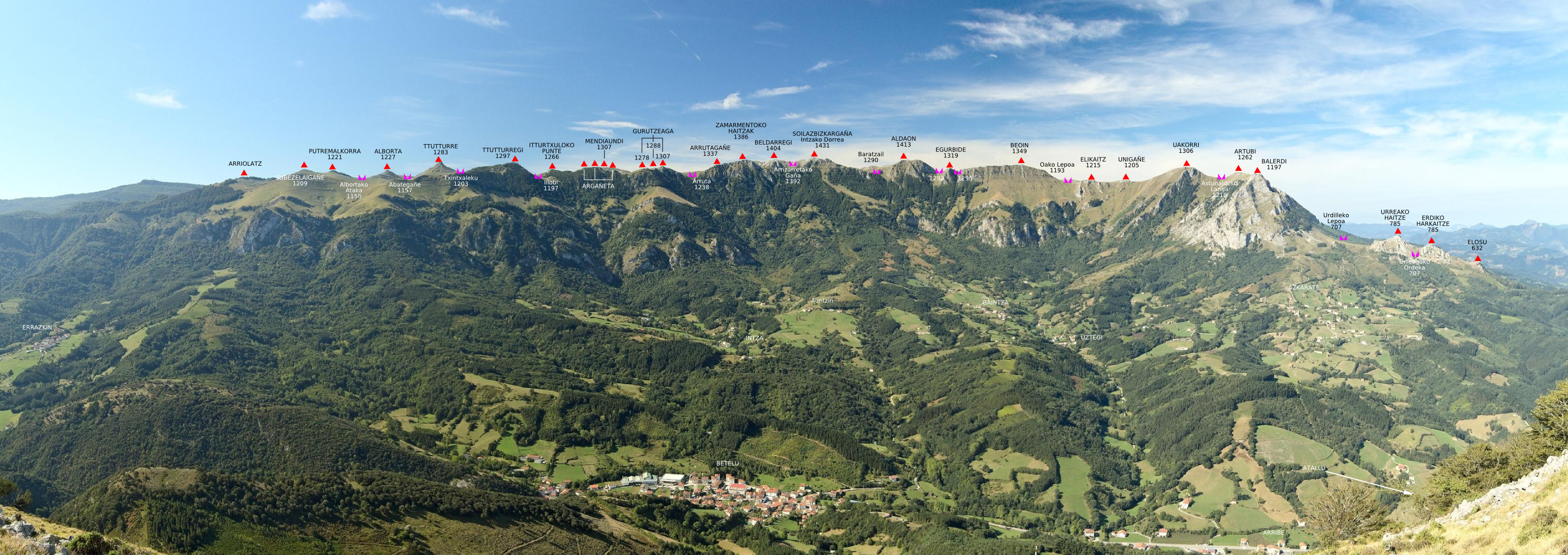Aralar Range on:
[Wikipedia]
[Google]
[Amazon]
The Aralar Range () is a
 The range is mountainous with large
The range is mountainous with large
 The materials that dominate are
The materials that dominate are
 Many streams originate in the range. Between the peaks, there are four large basins: Agauntza, Zaldibia, Ibiur and
Many streams originate in the range. Between the peaks, there are four large basins: Agauntza, Zaldibia, Ibiur and
 Megalithic monuments indicate prehistoric habitation of the range. These monuments include
Megalithic monuments indicate prehistoric habitation of the range. These monuments include
"Hiking in Spain"
Lonely Planet 2010. p140. Accessed at Google Books on 15 November 2013. The ethnographer and historian, José Miguel de Barandiarán, was born in the local town, Ataun.

 Also called 'Aralarko San Migel Santutegia' and 'Santuario de San Miguel de Aralar' in Spanish, San Miguel is a Romanesque church located in the southern part of the range near the town of Uharte-Arakil and Mount Altxueta (1343m). Records about the church date from the 11th century (1032) and it contributes to the history of Christianity in northern Spain—San Miguel is an iconic and one of the oldest saints of the Basques. The chapel was built by the lord of Goñi and consecrated 1098.Facaros D. and Pauls M
Also called 'Aralarko San Migel Santutegia' and 'Santuario de San Miguel de Aralar' in Spanish, San Miguel is a Romanesque church located in the southern part of the range near the town of Uharte-Arakil and Mount Altxueta (1343m). Records about the church date from the 11th century (1032) and it contributes to the history of Christianity in northern Spain—San Miguel is an iconic and one of the oldest saints of the Basques. The chapel was built by the lord of Goñi and consecrated 1098.Facaros D. and Pauls M
"Northern Spain"
New Holland Publishers, 2009 p105. Accessed at Google Books, 15 November 2013. However, there was an earlier 9th century structure on the same site in the
 Between May and November, livestock, especially latxa sheep which provide the milk for Idiazabal cheese, dairy cattle and a herd of wild horses, graze in the park's public pastures."Gipuzkoa Tour web magazine"
Between May and November, livestock, especially latxa sheep which provide the milk for Idiazabal cheese, dairy cattle and a herd of wild horses, graze in the park's public pastures."Gipuzkoa Tour web magazine"
Website in English accessed 14 November 2013. Although the ranges are generally uninhabited, some people of Aralar follow a nomadic life, tending their animals. Through the summer months, the sheep graze in the higher terrain. Pastoral huts have been built in these areas for shepherds. The animals winter near the villages.

 The varieties of birds of the range include griffons,
The varieties of birds of the range include griffons,
"Descubre Tolos Aldea Ezagutu"
Website in English accessed 14 November 2013

Information on navarra.com about the Aralar and Alsasua mountains.
{{Authority control Gipuzkoa Basque Mountains Mountain ranges of Navarre
mountain range
A mountain range or hill range is a series of mountains or hills arranged in a line and connected by high ground. A mountain system or mountain belt is a group of mountain ranges with similarity in form, structure, and alignment that have arise ...
in the Basque Mountains of Southern Basque Country
The Southern Basque Country ( eu, Hegoalde, Hego Euskal Herria; es, Hegoalde, País Vasco y Navarra, País Vasco peninsular) is a term used to refer to the Basque territories within Spain as a unified whole.
Name
In Basque language, natives ha ...
. The part of the range lying in Gipuzkoa
Gipuzkoa (, , ; es, Guipúzcoa ; french: Guipuscoa) is a province of Spain and a historical territory of the autonomous community of the Basque Country. Its capital city is Donostia-San Sebastián. Gipuzkoa shares borders with the French de ...
was established as a conservation area called Aralar Natural Park in 1994. In addition to its natural features, scenic beauty, recreational use and habitation, the range is home to a rich corpus of Basque mythology
The mythology of the ancient Basques largely did not survive the arrival of Christianity in the Basque Country between the 4th and 12th century AD. Most of what is known about elements of this original belief system is based on the analysis of ...
milestones and legends.
Etymology
TheBasque
Basque may refer to:
* Basques, an ethnic group of Spain and France
* Basque language, their language
Places
* Basque Country (greater region), the homeland of the Basque people with parts in both Spain and France
* Basque Country (autonomous c ...
word, 'Aralar' may stem from the words '(h)aran', meaning 'valley' and 'larre', meaning 'graze-land'. In Spanish
Spanish might refer to:
* Items from or related to Spain:
** Spaniards are a nation and ethnic group indigenous to Spain
**Spanish language, spoken in Spain and many Latin American countries
**Spanish cuisine
Other places
* Spanish, Ontario, Ca ...
, the range is also called ''Sierra de Aralar''.
Location
The range covers . is conservation area. The range is located in the Basque Country of northern Spain, straddling the boundaries of south-easternGipuzkoa
Gipuzkoa (, , ; es, Guipúzcoa ; french: Guipuscoa) is a province of Spain and a historical territory of the autonomous community of the Basque Country. Its capital city is Donostia-San Sebastián. Gipuzkoa shares borders with the French de ...
and north-western Navarre
Navarre (; es, Navarra ; eu, Nafarroa ), officially the Chartered Community of Navarre ( es, Comunidad Foral de Navarra, links=no ; eu, Nafarroako Foru Komunitatea, links=no ), is a foral autonomous community and province in northern Spain, ...
. The range effectively separates the two provinces. Pamplona
Pamplona (; eu, Iruña or ), historically also known as Pampeluna in English, is the capital city of the Chartered Community of Navarre, in Spain. It is also the third-largest city in the greater Basque cultural region.
Lying at near above ...
lies approximately to the south east. The Spanish coastline at the Cantabrian Sea
The Cantabrian Sea; french: Mer Cantabrique, gl, Mar Cantábrico, ast, Mar Cantábricu, eu, Kantauri. is the term used mostly in Spain to describe the coastal sea of the Atlantic Ocean that borders the northern coast of Spain and the southwes ...
(the southern Bay of Biscay
The Bay of Biscay (), known in Spain as the Gulf of Biscay ( es, Golfo de Vizcaya, eu, Bizkaiko Golkoa), and in France and some border regions as the Gulf of Gascony (french: Golfe de Gascogne, oc, Golf de Gasconha, br, Pleg-mor Gwaskogn), ...
) and the town of San Sebastian are approximately the same distance to the north north-east. The border between Spain and France is approximately to the north-east. Villages located at the foot of the range include Beasain
Beasain is a town and municipality located in the Goierri region of the province of Gipuzkoa, in the Autonomous Community of the Basque Country, northern Spain. It has an important industry of railway vehicles and related equipment ( CAF) ...
, Arbizu and Ataun. At Lizarrusti, a visitor centre marks the park's main entrance. It operates in the former miquelete (Gipuzkoan military police) barracks. The Aia hamlet (access via Aia road, NA120) nestles on the southern slopes of the range.
Geography
limestone
Limestone ( calcium carbonate ) is a type of carbonate sedimentary rock which is the main source of the material lime. It is composed mostly of the minerals calcite and aragonite, which are different crystal forms of . Limestone forms wh ...
massif
In geology, a massif ( or ) is a section of a planet's crust that is demarcated by faults or flexures. In the movement of the crust, a massif tends to retain its internal structure while being displaced as a whole. The term also refers to a ...
s (formations resulting from movement of the earth's crust into faults and flexures). This is typical of the Basque region. The range has a karstic lithological
The lithology of a rock unit is a description of its physical characteristics visible at outcrop, in hand or core samples, or with low magnification microscopy. Physical characteristics include colour, texture, grain size, and composition. Lith ...
appearance, i.e. parts of the calcareous
Calcareous () is an adjective meaning "mostly or partly composed of calcium carbonate", in other words, containing lime or being chalky. The term is used in a wide variety of scientific disciplines.
In zoology
''Calcareous'' is used as an a ...
( calcium carbonate, limestone) rock outcrops have been dissolved away in water. Left behind are limestone pavements—areas where the limestone has formed etched, pitted or fluted rock pinnacles and ridges between which are deep grooves, sinkhole
A sinkhole is a depression or hole in the ground caused by some form of collapse of the surface layer. The term is sometimes used to refer to doline, enclosed depressions that are locally also known as ''vrtače'' and shakeholes, and to openi ...
s or dolinas, caves, underground rivers, and gullies. An example, now open to the public, is the cavern of Mendukillo in the village of Astitz. This cracked, permeable geologic milieu has provided the perfect grounds for a wide range of mythological accounts and characters.
Geology
 The materials that dominate are
The materials that dominate are clay
Clay is a type of fine-grained natural soil material containing clay minerals (hydrous aluminium phyllosilicates, e.g. kaolin, Al2 Si2 O5( OH)4).
Clays develop plasticity when wet, due to a molecular film of water surrounding the clay part ...
, marl, sandstone
Sandstone is a clastic sedimentary rock composed mainly of sand-sized (0.0625 to 2 mm) silicate grains. Sandstones comprise about 20–25% of all sedimentary rocks.
Most sandstone is composed of quartz or feldspar (both silicates ...
and limestone
Limestone ( calcium carbonate ) is a type of carbonate sedimentary rock which is the main source of the material lime. It is composed mostly of the minerals calcite and aragonite, which are different crystal forms of . Limestone forms wh ...
. Except for quaternary period coatings, all the materials are from the Jurassic
The Jurassic ( ) is a Geological period, geologic period and System (stratigraphy), stratigraphic system that spanned from the end of the Triassic Period million years ago (Mya) to the beginning of the Cretaceous Period, approximately Mya. The J ...
and Cretaceous
The Cretaceous ( ) is a geological period that lasted from about 145 to 66 million years ago (Mya). It is the third and final period of the Mesozoic Era, as well as the longest. At around 79 million years, it is the longest geological period of ...
eras. The original limestone reefs create the element of ruggedness of the range. Two examples are the Txindoki relief and the Ataun dome structure. Sandstone is found to the north and south of the range. Glaciated areas with small frontal moraine
A moraine is any accumulation of unconsolidated debris ( regolith and rock), sometimes referred to as glacial till, that occurs in both currently and formerly glaciated regions, and that has been previously carried along by a glacier or ice sh ...
s at one to two km from the cirque
A (; from the Latin word ') is an amphitheatre-like valley formed by glacial erosion. Alternative names for this landform are corrie (from Scottish Gaelic , meaning a pot or cauldron) and (; ). A cirque may also be a similarly shaped landf ...
have been found.
Water sources
 Many streams originate in the range. Between the peaks, there are four large basins: Agauntza, Zaldibia, Ibiur and
Many streams originate in the range. Between the peaks, there are four large basins: Agauntza, Zaldibia, Ibiur and Amezketa
Amezketa (Spanish ''Amézqueta'') is a town located in the province of Gipuzkoa, in the Basque Autonomous Community, in the North of Spain. It is located at the foot of Txindoki.
References
External links
Official WebsiteInformation available i ...
in which streams can form. Due to the Karst geological forms, some waterways are underground. The waterways contribute to the economy of the region, for example, in the production of hydroelectric power.
Climate
The Basque region, generally, has a temperate oceanic climate. The climate of the Aralar range transitions between the Eastern Cantabrian climate ofGipuzkoa
Gipuzkoa (, , ; es, Guipúzcoa ; french: Guipuscoa) is a province of Spain and a historical territory of the autonomous community of the Basque Country. Its capital city is Donostia-San Sebastián. Gipuzkoa shares borders with the French de ...
and the Continental-Mediterranean climate of the Barranca corridor (Navarre
Navarre (; es, Navarra ; eu, Nafarroa ), officially the Chartered Community of Navarre ( es, Comunidad Foral de Navarra, links=no ; eu, Nafarroako Foru Komunitatea, links=no ), is a foral autonomous community and province in northern Spain, ...
). The mountains, however, do create their own micro-climate with more intense rainfall and greater cloud cover. Mists can make hiking in the park more dangerous.
History
tumuli
A tumulus (plural tumuli) is a mound of earth and stones raised over a grave or graves. Tumuli are also known as barrows, burial mounds or '' kurgans'', and may be found throughout much of the world. A cairn, which is a mound of stones b ...
, stone circle
A stone circle is a ring of standing stones. Most are found in Northwestern Europe – especially in Britain, Ireland, and Brittany – and typically date from the Late Neolithic and Early Bronze Age, with most being built from 3000 BC. The ...
s and menhir
A menhir (from Brittonic languages: ''maen'' or ''men'', "stone" and ''hir'' or ''hîr'', "long"), standing stone, orthostat, or lith is a large human-made upright stone, typically dating from the European middle Bronze Age. They can be fou ...
s. There are 17 on the Gipuzkoa
Gipuzkoa (, , ; es, Guipúzcoa ; french: Guipuscoa) is a province of Spain and a historical territory of the autonomous community of the Basque Country. Its capital city is Donostia-San Sebastián. Gipuzkoa shares borders with the French de ...
n side and 44 on the Navarre
Navarre (; es, Navarra ; eu, Nafarroa ), officially the Chartered Community of Navarre ( es, Comunidad Foral de Navarra, links=no ; eu, Nafarroako Foru Komunitatea, links=no ), is a foral autonomous community and province in northern Spain, ...
se side of the range. Archaeological evidence suggests Neolithic
The Neolithic period, or New Stone Age, is an Old World archaeological period and the final division of the Stone Age. It saw the Neolithic Revolution, a wide-ranging set of developments that appear to have arisen independently in several part ...
pastoralism. For example, primary forests, now restricted to the fringes of the range have been replaced by pastures. Also, a local mythology of legends, folk beliefs and tales, which is dependent on the nature of the landscape has emerged.Butler S"Hiking in Spain"
Lonely Planet 2010. p140. Accessed at Google Books on 15 November 2013. The ethnographer and historian, José Miguel de Barandiarán, was born in the local town, Ataun.
The Sanctuary of San Miguel in Excelsis
"Northern Spain"
New Holland Publishers, 2009 p105. Accessed at Google Books, 15 November 2013. However, there was an earlier 9th century structure on the same site in the
Carolingian
The Carolingian dynasty (; known variously as the Carlovingians, Carolingus, Carolings, Karolinger or Karlings) was a Frankish noble family named after Charlemagne, grandson of mayor Charles Martel and a descendant of the Arnulfing and Pippi ...
style. After a fire in the 10th century, the church was rebuilt with two aisles. The pillars are cruciform (one round). There is a simple fascia and no capitals. The church has three apses at the atrium, three barrel vaulted naves and a central polygonal dome. The altar front, featuring Our Lady, is enamelled. Nearby, in a grotto, there is a 12th-century shrine to San Miguel.
Legend holds that in a case of mistaken identity a crusader knight, the lord Teodosio of Goni, accidentally killed his own parents. In penance, he chained himself alone on Mount Aralar. An apparition dedicated to the archangel Michael appeared and released him. The apparition left an image, a figure with a glass (or crystal) head and face and a helmet adorned with a cross. The image was disfigured by the French in 1797. In the park there is also the Our Lady of Remedios Hermitage.
Land use
Hiking, mountaineering and
speleology
Speleology is the scientific study of caves and other karst features, as well as their make-up, structure, physical properties, history, life forms, and the processes by which they form ( speleogenesis) and change over time (speleomorphology ...
There are a number of trails, landmarks and unique destinations in the ranges. The karst features are suitable for caving.
Agriculture
Website in English accessed 14 November 2013. Although the ranges are generally uninhabited, some people of Aralar follow a nomadic life, tending their animals. Through the summer months, the sheep graze in the higher terrain. Pastoral huts have been built in these areas for shepherds. The animals winter near the villages.
Rural communities
Approximately 5112 people live in villages in the range; Abaltzisketa (290), Amezketa (1075), Ataun (1822), Zaldibia (1696) and Bedaio (229). They work in agriculture, in industries in larger towns and in tourism.Fauna

Animals
Animals of the range includeEuropean mink
The European mink (''Mustela lutreola''), also known as the Russian mink and Eurasian mink, is a semiaquatic species of Mustelidae, mustelid native to Europe.
It is similar in colour to the American mink, but is slightly smaller and has a less ...
, roe deer
The roe deer (''Capreolus capreolus''), also known as the roe, western roe deer, or European roe, is a species of deer. The male of the species is sometimes referred to as a roebuck. The roe is a small deer, reddish and grey-brown, and well-adapt ...
, wild boar and various small and medium mammals such as Pyrenean desmans and the European snow voles. There are amphibians such as the alpine newt
The alpine newt (''Ichthyosaura alpestris'') is a species of newt native to continental Europe and introduced to Great Britain and New Zealand. Adults measure and are usually dark grey to blue on the back and sides, with an orange belly and thro ...
s.
Birds
 The varieties of birds of the range include griffons,
The varieties of birds of the range include griffons, Egyptian vulture
The Egyptian vulture (''Neophron percnopterus''), also called the white scavenger vulture or pharaoh's chicken, is a small Old World vulture and the only member of the genus ''Neophron''. It is widely distributed from the Iberian Peninsula an ...
s, golden eagle
The golden eagle (''Aquila chrysaetos'') is a bird of prey living in the Northern Hemisphere. It is the most widely distributed species of eagle. Like all eagles, it belongs to the family Accipitridae. They are one of the best-known birds ...
s, and bearded vulture
The bearded vulture (''Gypaetus barbatus''), also known as the lammergeier and ossifrage, is a very large bird of prey and the only member of the genus ''Gypaetus''. Traditionally considered an Old World vulture, it actually forms a separate ...
s, Alpine chough
The Alpine chough (), or yellow-billed chough (''Pyrrhocorax graculus'') is a bird in the crow family, one of only two species in the genus '' Pyrrhocorax''. Its two subspecies breed in high mountains from Spain eastwards through southern Europ ...
s, wood pigeons and black woodpeckers
The black woodpecker (''Dryocopus martius'') is a large woodpecker that lives in mature forests across the northern Palearctic. It is the sole representative of its genus in that region. Its range is expanding. The black woodpecker is easily th ...
.
Flora
The range is known for its beech forests. In times past, beech pollards have been used to make charcoal. There are also groves of rowan and hawthorne and Cantabrian holm oak.Mountains
The Dome of Ataun
This scenic plateau feature is created by the peaks of Jentilbaratza, Aizkoate, Aizkorrandi, Arastortz, Agautz, Leizadi, Asundi, Loibideko Mailoak and Ikarandieta.Txindoki
This is by far the most widely known and visited peak in the range. The peak is called "Little Cervine" and the mountain itself, the 'Basque Matterhorn'.Website in English accessed 14 November 2013
Intzeko Torrea
''Tower of Intza'', also called “Irumugarrieta”, is the highest mountain of the range.
Peaks to
* Aizkoate (774 m) * Artzate Haitza (656 m) * Aixita (705 m) * Itaundieta (627 m) * Madalenaitz (860 m) * Otsabio (801 m) * Urbara] (748 m) * Urreako Haitza (784 m)Peaks to
* Agaotz (974 m) * Akaitz Txiki (942 m) * Amezti (mendia) (982 m) * Amiltzu (828 m) * Arastortzeko-gaña (813 m) * Ausa-gaztelu (904 m) * Egillor (mendia) (911 m) * Intzartzu (811 m) * Laparmendi (812 m) * Leitzadi (921 m) * Malkorburu (862 m) * Martxabaleta (841 m) * Marumendi (821 m) * Sarastarri (996 m) * Serlo Gaina (919 m)Peaks to
* Akaitz (1.078 m) * Akier (1.124 m) * Alitzako Malkorra (1.069 m) * Alleko (1.018 m) * Arriolatz (1.176 m) * Balerdi (1.197 m) * Debata (1.139 m) * Elorrigañe (1.063 m) * Etitzegi (1.196 m) * Gaztelu (mendia) (1.085 m) * Iparraundi (1.064 m) * Iruaundi (1.064 m) * Larrazpil (1.066 m) * Larraone (1.199 m) * Maldako Punta (1.012 m) * Soroaundi (1.045 m) * Txurtxur (1.069 m) * Zabalegi (mendia) (1.114 m)Peaks to
* Aitzear (1.286 m) * Alborta (1.228 m) * Aoki (mountain), Aoki (1.317 m) * Aparein (1.261 m) * Artxueta (1.343 m) * Atallorbe (1.275 m) * Arbelo (1.332 m) * Arrubigaña (1.318 m) * Artubi (1.263 m) * Auntzizegi (1.248 m) * Beaskin (1.242 m) * Beleku I (1.256 m) * Beoin (1.350 m) * Beloki (mendia), Beloki (1.271 m) * Desamendi (1.305 m) * Desamendi Txiki (1.261 m) * Egurbide (1.317 m) * Egurtegi (1.320 m) * Elizkaitz (1.215 m) * Erlabeltzeko Puntie (1.312 m) * Elizkaitz (1.215 m) * Erlabeltzeko Puntie (1.312 m) * Errenaga (1.282 m) * Errenaga Txiki (1.277 m) * Eulata (1.281 m) * Ganbo Txiki (1.382 m) * Gañeta (1.323 m) * Hirupagoeta (1.235 m) * Ipuzmeaka (1.216 m) * Kargaleku II (1.253 m) * Kobagaine (1.324 m) * Kurutzeaga (1.308 m) * Labeongo Punte (1.293 m) * Malkorri (1.329 m) * Mendiaundi I (1.307 m) * Olamuño (1.261 m) * Ondar-txuri (1.220 m) * Ontzanburu (1.281 m) * Pagota (1.271 m) * Pallardi (1.290 m) * Pardarri (1.393 m) * Putreaizko Punta (1.383 m) * Putxerri (1.299 m) * Salingain (1.322 m) * San Miguel (mountain), San Miguel (1.237 m) * Subizelaigañe (1.209 m) * Ttutturre (1.282 m) * Txameni (1.299 m) * Larrunarri/Txindoki (1.245 m) * Txorrotxeta (1.273 m) * Uakorri (1.306 m) * Uarrain I (1.346 m) * Uarrain II (1.221 m) * Uazkuru (1.249 m) * Urkute (1.328 m) * Uzkuiti (1.332 m) * Zumalerdi (1.215 m)Peaks to
* Aldaon (1.411 m) * Beldarri (1.405 m) * Ganboa (1.402 m) * Intzako dorrea (1.431 m)Best known peaks
*Aldaon (1,411m) *Artubi (1,262m) *Artxueta (1,343m) *Balerdi (1,195m) *Beoain (1,359m) *Ganboa (1,412m) *Irumugarrieta (1,431m) *Pardarri (1,393m) *Putterri (1,299m) *Uarrain (1,346m) *Txindoki
Txindoki or Larrunarri is an iconic mountain (1,346 m) located in the region of Goierri, Gipuzkoa, in the Basque Autonomous Community of Spain. Originally Larrunarri or Ñañarri (), the mount took on the popularized name Txindoki by extension aft ...
or ''Larrunarri'' (1,346 m).
See also
*TheAralar Party
Aralar was a Basque socialist and separatist political party in Spain. It was opposed to the violent struggle of ETA.
History
Aralar was born in the 1990s from a critical tendency within Herri Batasuna (HB) and Euskal Herritarrok (EH), led by Pat ...
is named after the range.
References
External links
Information on navarra.com about the Aralar and Alsasua mountains.
{{Authority control Gipuzkoa Basque Mountains Mountain ranges of Navarre